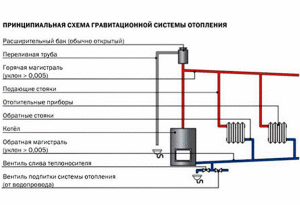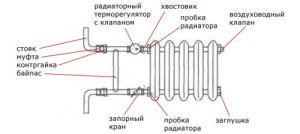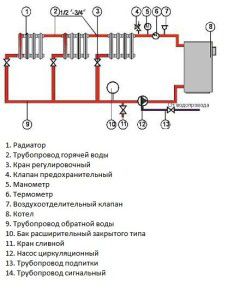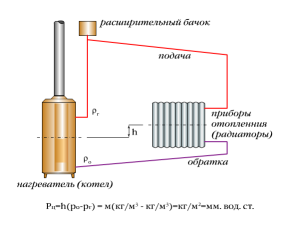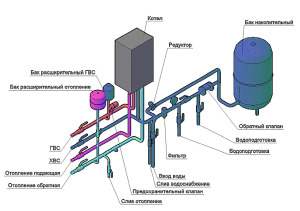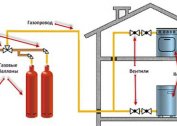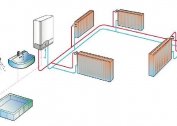Self-assembly of heating is a responsible task, requiring a methodical approach to all stages. Each of them should be accompanied by the necessary calculations and analysis of the installation technology, as well as the selection of the appropriate elements. How to install the heating yourself, so that in the end you get a reliable and easy to maintain system to maintain a comfortable temperature level in the house?
Overview of circuits and components of the heating system
At the first stage, it is necessary to choose the principle of operation of the heating system. Even 20-25 years ago, there was practically no alternative - they made a gravitational open system. Therefore, the question of how to properly install the heating was reduced to the choice of the diameter of the steel pipes and their correct slope. But the appearance on the market of the basic elements of a closed system has greatly expanded the possibilities of choosing a scheme.
Gravity heating system
The main source of water heating for it is a solid fuel boiler (it is possible to work on a diesel engine or used oil). Installation of gas models is not possible, since their normal functioning implies increased pressure in the pipes. Self-assembly of a heating system with a gas boiler is possible. But in this case, a solid fuel housing is used, in which a special gas burner is mounted.
Before you properly install heating in a private house, you need to select its main components. In addition to the boiler, the following elements are mandatory:
- Pipes. For this type of heating, you can use plastic models (polypropylene, metal-plastic) or steel. The diameter is best chosen large - from 40 mm. In this way, the overall hydraulic resistance can be reduced;
- Expansion tank. It is necessary to stabilize the system in case of overheating of the coolant;
- Stop valves. Its installation is mandatory, since during repair or maintenance work it will be necessary to shut off the flow of coolant in a certain section of the system;
- Make-up unit. It will be required to add coolant. In order to optimize it, it is often included in the design of an expansion tank.
The gravity system in most cases is made single-tube (Leningrad). In order to properly install the heating radiator, it is necessary to install a bypass on each of them. This also needs to be taken into account when purchasing components and drawing up a general installation diagram.
In addition to these components, installation of pressure gauges is necessary. If this device is not provided in the design of the boiler, it should be installed on the outlet pipe.
To mount the heating radiator, it is necessary to provide for the presence of a Mayevsky crane in it. It is necessary to eliminate air congestion in the system.
Circuit diagram of a forced circulation heating system
It is much more difficult to install a forced circulation heating system. The difference is to create increased pressure in the line. This helps to increase the length of the pipelines and the optimal temperature regime of the entire system.
The complete set of this scheme is best considered with the example of a solid fuel boiler strapping. Since in the majority of gas models, the overwhelming majority of components are included in the structure (circulation pump, expansion tank, etc.).Therefore, in order to install the heating system itself, in addition to the boiler, the system must necessarily contain:
- Circulation pump. It will create the necessary level of coolant pressure;
- Closed expansion tank. It serves as a compensator when the pressure in the system rises above critical;
- Security group. Partially duplicates the functions of the expansion tank. If the pressure readings are too high, the air vent and drain valve will reduce it, removing excess air and coolant from the system;
- Stop valves;
- Make-up unit.
How to install a closed-circuit heating system yourself, and most importantly - which pipe layout to choose? Experts recommend installing a two-pipe, since the radiators in this case will be connected in parallel, which will ensure uniform temperature distribution throughout the system.
Installing a forced-type heating system is much simpler than with natural circulation. In addition, the first is the only option for houses with medium and large areas.
Installation of a heating system
Regardless of the selected scheme, before installing heating in a two-story house, you need to draw up a preliminary plan for the installation of pipes and system components. To do this, you will need a floor plan on which all components will be indicated.
According to the plan, you need to purchase all components and elements. How to install heating from polypropylene and correctly calculate the flow rate of pipes? This is best done for each room individually. Based on the data obtained, the optimal pipe size is selected - 3 or 6 m. Then you can proceed directly to the installation.
Installation of gravity heating
For proper cabling, a boiler is first installed. If its weight at full fuel loading exceeds 450-500 kg, a separate foundation should be equipped first. It is possible to correctly install gravity-type heating, observing the optimum height between the boiler and radiators.
In addition, the length of the overclocking manifold must be taken into account. It depends on the height of the building, since the expansion tank is usually located in the attic.
After installing the boiler, you can proceed to the following installation steps:
- Pipe strapping. First, a vertical booster pipe from the boiler is installed and then horizontal lines are connected to it. The angle of inclination of the supply and return pipes should be 5 mm per 1 mp;
- Installation of radiators. To properly mount the heating in a private house, first make connection pipes for each battery. Their location depends on the method of connection to the radiator (top, bottom, side). The distance (height) of the battery is taken into account;
- Connect all nodes into a single network;
- System filling.
You cannot permanently install any heating system without first checking it. To do this, it is filled with water, while the boiler does not start. Checks the reliability of all connecting nodes, the absence of leaks. Then the boiler is turned on at minimum thermal operation. The increase in power occurs gradually with a one-sided check for the absence of air jams, i.e. uniform heating of pipes and radiators. Is it difficult to install this type of heating system yourself? If you choose the right accessories and tools - this is doable. The choice of tool for laying pipelines depends on the pipe material. For steel products you will need a welding machine, for plastic a special soldering iron.
Do not mount a heating system with pipes of various diameters in the main. This will lead to an increase in hydraulic resistance and, as a consequence, to a decrease in circulation.
Installation of heating with forced circulation
If you need to install heating in a two-story house with forced circulation - the procedure will be different. The gas heating boiler is the last to be installed. This is due to the lack of an overclocking collector and optional observance of the angle of inclination of the pipelines. On the contrary, highways should be located strictly horizontally.
For such a scheme, polypropylene heating is most often mounted. This is due to the simple installation of plastic pipes, their affordable cost. First, following the drawn up scheme, the installation of individual sections of the highway is done. Then they are connected into a single network. In this case, the following points should be provided:
- Mounting of heating radiators is performed by bottom or side connection;
- The volume of the expansion tank and the capacity of the circulation pump are selected according to the parameters of the system;
- Installation of the protection group is carried out immediately after the boiler. It is important that there is no stop valve between them.
After connecting the boiler to a properly installed heating, pressure testing is carried out. During this process, the pressure should exceed the standard 1.25 times.
The performance check is carried out according to the same scheme as for the gravitational system. The only difference is that when filled with coolant, its level is determined by the pressure value, which is monitored on installed pressure gauges.
For the correct installation of heating in a private house, it is recommended that all work be performed in the summer. This will affect the level of comfort during the performance of work and there will always be enough time to redo a particular section of the system in case of a malfunction or incorrect calculations.
An alternative to the above systems can be heating for a house without pipes, an example of which can be found in the video material. However, one must take into account the increase in current energy costs - electricity.
